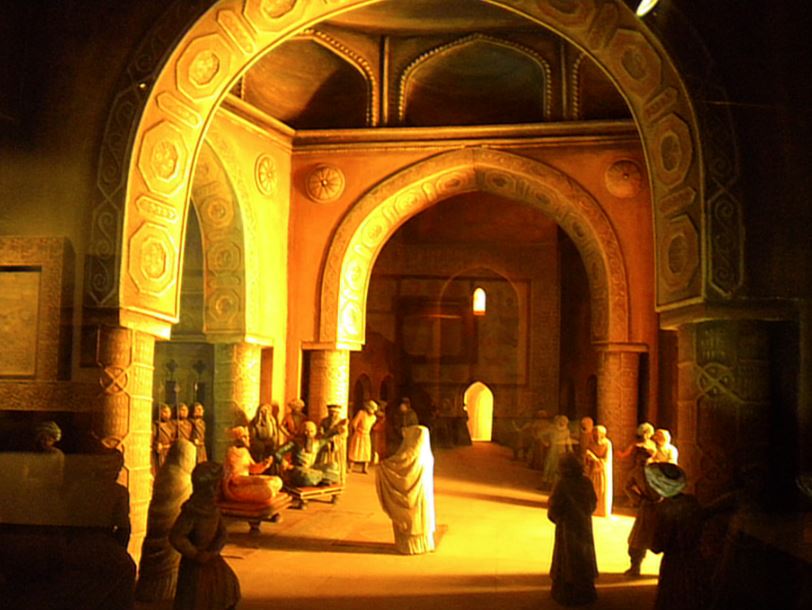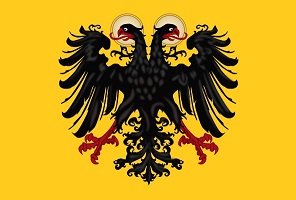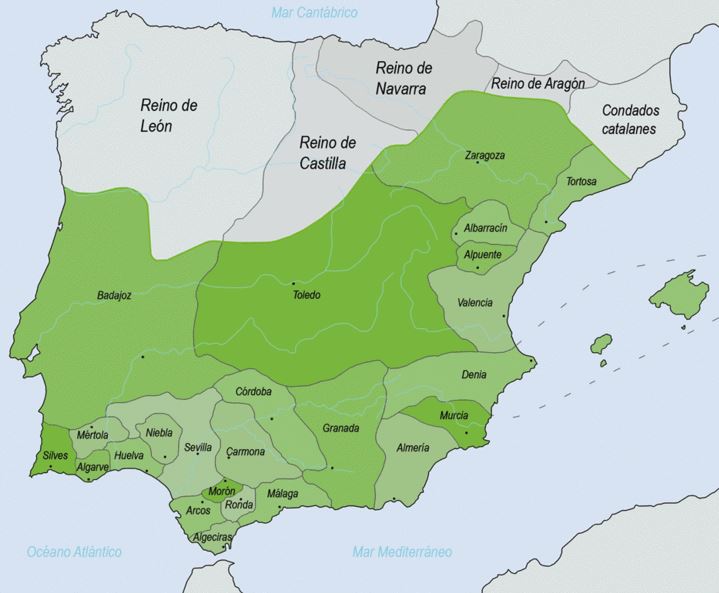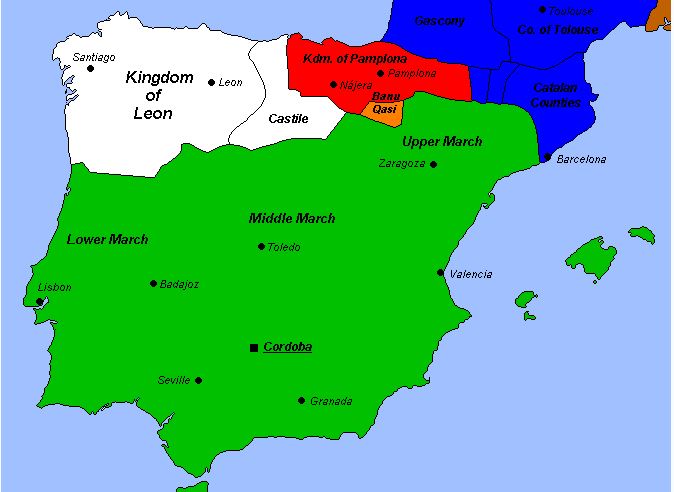If
you would like to support this web site and the amount of research it
involves, I will be grateful and will give you access to a library of
resources
QUICK
LINKS IN THIS PAGE
Saadia Gaon
(4688 AM - 928 CE)
The dispute of the Babylonian Jewry
(4697 AM - 937 CE)
Hasdai ibn Shaprut
(4709 AM - 949 CE)
The Holy Roman Empire
(4722 AM - 962 CE)
The Fear of the year 1000
(4762 AM - 1000 CE)
Rabbi Amnon of Mainz
(4781 AM - 1020 CE)
End of the Caliphate of Cordoba
(4791 AM - 1031 CE)
Samuel ha-Nagid
(4798 AM - 1038 CE)
End of the Gaonim
era
(4800 AM - 1040 CE)
Solomon ibn Gabirol
(4800 AM - 1040 CE)
|
Previous
<< Generation
40 >> Next
Hebrew years 4680 to 4800 (920 - 1040 CE)
This
40th generation witnessed the collapse of central authorities
in the
three monotheist religions. But Judaism experienced a golden age with
the emergence of great thinkers in new regional centers that
helped established the religion more firmly despite difficult
times and instable political conditions.
Year
4688 – 928 CE – Saadia
Gaon
The
next challenge faced by Rabbi Saadia came from Israel when the head of
the talmudic schools there, Rabbi Aaron ben Meir, endeavoured to move
the
religious authority
back from Babylon to Israel. This was at a time when the Babylonian
Jewish leadership was in turmoil with a dispute between the schools of
Sura and Pumbedita over authority. Rabbi Aaron tried to
foster his position when time came to set the Jewish calendar in 922
CE: he
claimed that the Babylonian Gaonim were wrong. But the latter received
support from Rabbi Saadia himself who, being knowledgeable on
astronomy, could point to the mistakes made by Rabbi Aaron. The dispute
was resolved and letters sent to all the Diaspora, and finally
the authority of Babylon was restored. In recognition to Rabbi Saadia's great knowledge on religious
matters and his defence of core Judaism
against the Karaites, he received the honour to become head of the
school of Sura in 928 CE. After accepting the role, he became
known as Saadia Gaon.
~ ~ ~ ~ ~  ~ ~ ~ ~ ~ ~ ~ ~ ~ ~
Year 4697
– 937 CE – The dispute of the Babylonian Jewry
In
930 CE, the Jewish leadership was again in turmoil owing to the clash
between the two main authorities. Saadia Gaon accused the
Exilarch David ben Zakkai, who was in function since 917 CE,
of avarice and unlawful actions in regards to Jewish laws. The Exilarch
was the one who proposed Saadia as Gaon of Sura in the first place. In
their dispute, each leader
excommunicated the other, and the entire community was on the brink of
collapse by schism. In 937 CE, the dispute was brought to the arbitrage
of the Caliph of Baghdad, who convinced the two leaders to continue in
their respective role. But the scars never healed between the
two
camps, until they both died, ben Zakkai in 940 and Saadia Gaon in 942.
 Saadia
Gaon before the Caliph of Baghdad in 937 CE (photo: Albert Benhamou,
Bet Hatfusoth, Tel-Aviv)
Saadia
Gaon before the Caliph of Baghdad in 937 CE (photo: Albert Benhamou,
Bet Hatfusoth, Tel-Aviv)
Saadia Gaon had proved a prolific writer, both in Hebrew and Arabic.
Some of his works are as follows:
- Emunoth ve-Deot
(Faith and Knowledge) [1a]:
this was an attempt, the first since the works of Philo of Alexandria,
to reconcile faith and philosophy; this book was written in Arabic to
help educate the vast majority of Jews, who only spoke this language at
the time, who started to have doubts about their faith in the face of
increased pressure from both Christian and Muslim influences
- a commentary
in Hebrew of the ancient Sefer
Yetzirah [1b]:
this book of cabbalistic nature was an attempt to explain the Biblical
Creation and the role of the Hebrew Alphabet in this divine act; Saadia
Gaon was the first to offer a commentary of this obscure book, and he
attempted to explain it in the context of the scientific knowledge of
his times (for example in drawing parallels with the number of nature
of the seven planets); it was later followed
by commentaries from several other sages in
the centuries to come
Saadia Gaon was the most famous and one of the last of Gaonim.
~ ~ ~ ~ ~  ~ ~ ~ ~ ~ ~ ~ ~ ~ ~
Year 4709
– 949 CE – Hasdai ibn Shaprut
In
Al-Andalus, the scholar Hasdai ibn Shaprut, born in 915 from a wealthy
Jewish family, was appointed physician to the Calife Abd ar-Rahman.
Beside being a scholar and a man of Sciences, he was also a diplomat.
He entertained correspondance with leaders of the various states of his
times, as well of course with heads of the Jewish establishment in
Babylonia. Under his leadership, Al-Andalus started to become
a
place of Jewish scholarship who attracted many Jewish thinkers who
could rely upon Hasdai's protection. This also happened at the time
when the religious authorities in Babylon were in conflict with the
Exilarchy. This dispute contributed to create other Jewish centers
outside Babylonia.
Later
in life, Hasdai heard about Khazaria having adopted Judaism as state
religion. His entousiasm knew no limtit. He sent emissary to the king
of Khazaria in about 960 and entertained a correspondance which had
been discovered in the 19th century.[2] Hasdai
died some years later about 970. Thanks to the patronage of ibn
Shaprut, the Jewry of Al-Andalus enjoyed a golden age that continued to
last beyond his lifetime.
~ ~ ~ ~ ~  ~ ~ ~ ~ ~ ~ ~ ~ ~ ~
Year 4722
– 962 CE – The Holy Roman Empire
After the
success of
Charlemagne to unite the parts of the previous Western Roman Empire
into one empire again, his successors started the division again under
Carolingian kings. But the Central European region was unified again in
one empire under Otto the Great as the Holy Roman Empire in 962 CE.
This empire included most of modern-day Germany, northern Italy,
Austria and central European states bordered in the East by Poland, in
the South by the Balkans and the Byzantine Empire, and in the West by
the Frankish kingdom. Otto was crowned emperor in Rome by the Pope and
reigned from the imperial city. But conflicts finally raised between
him and the religious authorities and he finally moved to Germany in
972 before dying there a year later.
The Holy Roman
Empire lasted for 844 years until Napoleon put an end to it in 1806.
 Banner of the
Holy Roman Empire
Banner of the
Holy Roman Empire
~ ~ ~ ~
~  ~ ~ ~ ~ ~ ~ ~ ~ ~ ~
Year 4760
– 1000 CE – The Fear of an Apocalyptic Year: myth or reality?
In Medieval times, there was a
popular belief that te world will come to an end in 1000. The reason
for this date was the perception that the world will end 1000 years
after Jesus' birth. Before the doomed time, people started to make
penitence more than ever before. But, when the year 1000 passed,
nothing had happened. There was a risk of decrease in Faith. So a new
date was set: the 1000 years should have been counted not from Jesus'
birth but from Jesus' crucifixion. This date was set to be the year
1033. Then 33 years passed on and nothing happened.
The
existence of this Fear may however have
nurtured in the minds of later historians. In the 19th century, no
serious historian believed in it. The main argument against its
existence is that the Medieval world did not have a full understanding
of chronology over long periods of time, and didn't even have the
numerical system to calculate what the number 1000 was. Dates were set
by the years of reignor major events. The monks even got the
calculation of the year for Jesus' birth wrong. Yet, other research
showed that around year 1000 a lot of writings of apocalyptic nature
appeared in the Christian world: this cannot be understood as a mere
coincidence.
The
facts are that, in this
11th century, the Church was however going through an internal crisis
of "apocalityc nature" that led to the Great Schism. The Holy Land also
was in turmoil with a series of natural catastophes and no less than
three powerful earthquakes that destroyed many buidings in Jerusalem.
Politically, the previaling rule of the Abbasid was coming to an end and
the Holy Land changed hands a few times in that century, from Abbasid
to Fatimid (El-Hakim, one of the Fatimid rulers, even destroyed the Holy
Sepulchre in 1009), then to Saljuk and to Fatimid again a few months before the
Crusaders took Jerusalem in 1099. The Crusades themselves have been
nurtured by the Church as a necessity to free the tomb of Jesus from
Muslim hands, and a way to avoid the doomed Apocalypse in these
times.
~ ~ ~ ~
~  ~ ~ ~ ~ ~ ~ ~ ~ ~ ~
Year 4781
– 1020 CE – Rabbi Amnon of Mainz
Rabbi Amnon was the leader of the
Jewish community of Mainz. He was a reknown scholar, respected even by
the Christian authorities led by the Archbishop of Mainz, Willigis, who
had held his role for many years, from 975, and was himself a very well
respected leader. But when he died in 1011, he was replaced by a mere
abbot, Erkanbald, Abbot of Fulda, who owned his election thanks to his
family who was well connected with the ruler of Germany. At first,
Erkanbald continued the good relation that Willigis had with Rabbi
Amnon. But, in September 1020, a few days before the Jewish New Year of
4781, Erkanbald requested from Rabbi Amnon to convert to Christianity.
The latter asked for three days to consider. But when he got back to
his home, he felt distraught
to have even questioned the possibility of conversion by asking some
time, which he saw as his betrayal of God. He spent the three days in
fasting and asking for repentance from God. After the delay, Rabbi
Amnon was brought by force in front of the Bishop of Mainz who demanded
his response. The Rabbi answered that he should have his tongue cut out for having asked any delay and not having refused in the first place. The
Bishop became very angry and ordered not only to cut the Rabbi's tongue, but
also his feet for not having come to him by his own will, and also
ordered his hands to be cut off. The Rabbi was then taken back to his
home. When Rosh Hashanah came the next day, Rabbi Amnon, who was dying
from bleeding, asked to be carried to the synagogue to sanctify the
name of God for a last time. There he uttered a prayer that he had just
composed and died in the synagogue. Three days later, he appeared to one of his disciples, Rabbi Kalonymus ben Meshullam,
from the prestigious family Kalonymos (originated from Lucca,
Italy), to teach him the words of his final prayer, requesting that it should be
recited in all synagogues during the prayers of Rosh Hashanah and Yom Kippur. Since this time, the prayer, called Unetanneh Tokef,
is indeed part of these prayers. The text portrays God as a shepherd
who counts His flock (mankind), one by one, to judge them on the Day of
Judgment:All
mankind will pass before You like a flock of sheep. Like a shepherd
pasturing his flock, making sheep pass under his staff, so shall You
cause to pass, count, calculate, and consider the soul of all the
living; and You shall apportion the destinies of all Your creatures and
inscribe their verdict.On
Rosh Hashanah will be inscribed and on Yom Kippur will be sealed - how
many will pass from the earth and how many will be created; who will
live and who will die; who will die at his predestined time and who
before his time; who by water and who by fire, who by sword, who by
beast, who by famine, who by thirst, who by upheaval, who by plague,
who by strangling, and who by stoning. Who will rest and who will
wander, who will live in harmony and who will be harried, who will
enjoy tranquility and who will suffer, who will be impoverished and who
will be enriched, who will be degraded and who will be exalted.
But Repentance, Prayer, and Charity avert the severe Decree!--- Extract from the prayer Unetanneh Tokef
Erkanbald died a few months
later too, on 17 August 1021 (corresponding to the date of 29 Av 4781),
which falls in the same year as Rabbi Amnon, who died on Rosh Hashanah
4781. Erkanbald's office in Mainz only lasted 10 years unlike his
predecessor who was blessed with 36 years in office.
~ ~ ~ ~
~  ~ ~ ~ ~ ~ ~ ~ ~ ~ ~
Year 4791
– 1031 CE – End of the Caliphate of Cordoba
When the last
powerful Caliph of
Cordoba died in 976, he named as a successor his 10 years old son.
Since, the Caliphate suffered a steady decline. The child's key advisor
was the actual regent and he allowed Berbers to come from Africa to
build his own personal support. This created a legitimacy issue, as the
powerless Caliph was quickly manipulated by factions. The caliphate
ultimately collapsed in 1031 and split into many regional taifa kingdoms.
 The taifas
kingdoms after 1031 CE (source: Wikipedia)
The taifas
kingdoms after 1031 CE (source: Wikipedia)
During the taifas
period, and depending on the ruler in charge in any given city, the
Jews moved from one city to another to escape persecutions. Some
eventually moved north to the Christian dominions too, and
even over the Pyreneans into the Languedoc region.
~ ~ ~ ~
~  ~ ~ ~ ~ ~ ~ ~ ~ ~ ~
Year 4798
– 1038 CE – Samuel ha-Nagid
Samuel ibn
Naghrillah (or Naghrela), who became known as ha-Nagid,
was born in Merida, Al-Andalus, in 993. He
played a very important role between Jews and Muslims because he served
as vizir to the Berber king who took Cordoba in 1013, and, in
1038, became the vizir and chief of armies for the king's son
and
successor. And indeed Samuel got to engage in many battles in his time.
In total, he held the post of vizir for about 30 years until
his death in 1056. His writings are mainly composed of religious
poetry.
Cordoba
later fell to the Christians in 1091.
~ ~ ~ ~
~  ~ ~ ~ ~ ~ ~ ~ ~ ~ ~
Year 4800
– 1040 CE – End of the Gaonim
era
In Sura, the
Gaon Samuel ben Chofni died in 1034 CE. He was not
replaced in this position and thus was the last Gaon of Sura.
In
Pumbedita, Hezekiah ben David was tortured to death in 1040 and was
never replaced. He was the last Gaon of Pumbedita. His sons escaped to
Muslim Spain where they found refuge with the Jewish community in
Al-Andalus which was flourishing at the time due to the presence of
great scholars.
With the death
of the two Jewish leaders of Babylonian Jewry ended the era of the
Gaonim. At
that time, Babylonia was no longer the main center of Jewry as other
centers had developed and prospered over the past centuries, notably in
Cordoba (Spain), in Kairuan (North Africa), Fustat near Cairo (Egypt)
and in Christian Europe. The loss of Babylonian preponderance in
the world Jewry of the time was parallel to the decline of
Abbasid Caliphate over the Muslim world which saw the emergence or
strenghening of
other Caliphates: Al-Andalus, the Western Maghreb with the Umayyads,
the
Eastern Maghreb with the Aghlabids, principally.
 The
Caliphate of Cordoba in 1000 CE (source: Wikipedia)
The
Caliphate of Cordoba in 1000 CE (source: Wikipedia)
~ ~ ~ ~
~  ~ ~ ~ ~ ~ ~ ~ ~ ~ ~
Year 4800
– 1040 CE – Solomon ibn Gabirol
Solomon ibn
Gabirol was born in
Malaga, Al-Andalus, in 1021. His parents both died when he was very
young and he found solcae in the studies of the Talmud. He rapidly
showed great skills in composing religious poetry. Before the age of
20, he already composed some poems that have been included in the
Jewish daily and festivals prayers. But many of his poems reflect the
sadness and the difficulties of his personal life, and hope for
redemption at the hand of God:
Lord,
what is man but flesh and blood? O weep !
His days unconscious stray, like shadows sweep,
His stroke comes sudden and he falls on sleep.
Lord, what is man? A carcase fouled and trodden
A
noxious creature brimming with deceit,
A
fading flow'r that shrivels in the heat.
Wert
Thou as stern as he with sin is sodden,
How
could he face Thy wrath? Ah, see him creep:
His
stroke comes sudden and he falls on sleep.
---
Ibn Gabirol, "Lord, what is man?", first paragraph [3]
~ ~ ~ ~
~  ~ ~ ~ ~ ~ ~ ~ ~ ~ ~
Notes:
[1a] To read the
book online in its Hebrew translation, click here ; to read the page of
this chronology about the Sefer Yetzirah, click
here
[1b] To read the
book online in one of the English translations (Dr Isidor Kalisch, New
York, 1877), click here
[2] This
correspondance is generally published as an addition to
the Book
of Kuzari, mentioned in next
generation
[3] To read severeal
of Ibn Gabirol's poems online, click here
Next
generation
Click to Print
This Page
|
